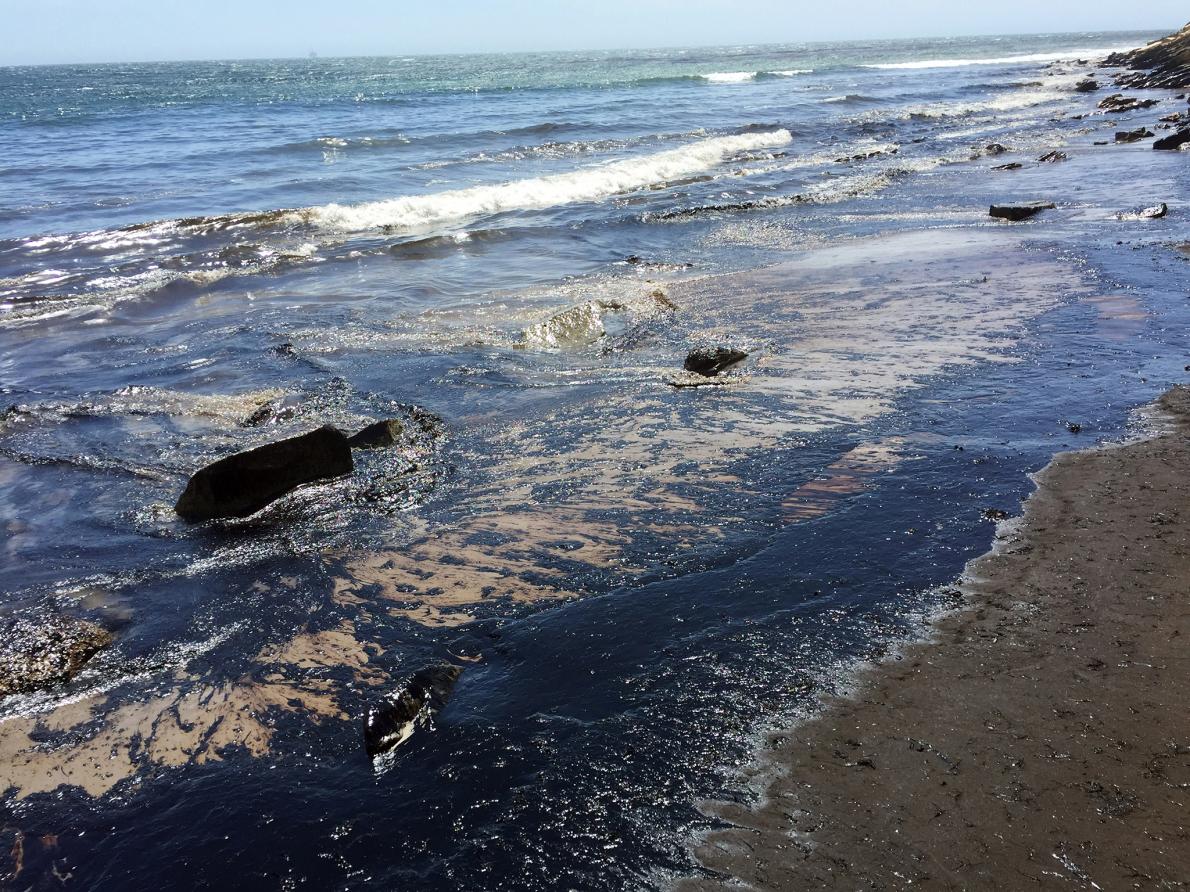Santa Barbara Beaches Slicked With Oil After Pipeline Breach

Mark Tautrim was checking fences along his coastal cattle ranch 20 miles west of Santa Barbara on Tuesday afternoon when he caught a whiff of oil so strong it gave him a headache.
“Gosh, do you think the pipeline is leaking?” his wife, Susie Tautrim, asked him.
Tautrim headed toward the beach to investigate. He was among the earliest witnesses to an oil spill that has coated several miles of beaches along one of California’s most ecologically important shorelines.
A broken pipeline off Goleta, California, spilled an estimated 21,000 gallons of heavy black crude oil into the Pacific Ocean on Tuesday. The spill is along the same beaches contaminated by a 1969 oil-platform blowout that is widely credited with sparking the U.S. environmental movement.
The oil has spread to a nine-mile slick off Refugio State Beach and an adjacent shoreline, forcing authorities to shut down the popular state beach and campground as Memorial Day weekend approaches. It is near protected nesting grounds of an endangered bird.
Mark Tautrim says humpback whales are moving through the region now, and other witnesses have reported seeing whales and sea lions swimming through the sheen.
“It’s horrible,” Susie Tautrim says. “This is the jewel in the crown of the Central and Southern California coast. It’s protected. It’s beautiful. We regularly see dolphins and whales. It’s really biologically diverse.”
Rescue centers officially said Tuesday that they had found no oiled birds, but photos are emerging on social media. Western snowy plovers, a federally protected threatened species, nest on protected beaches nearby at University of California, Santa Barbara’s Coal Oil Point Reserve, but the location had not been hit by oil as of Wednesday morning.
California Department of Fish and Wildlife officials said in a press conference Wednesday that they have seen pictures of dead fish and birds but had no official estimate of ecological damage.
“Undoubtedly there’s been impacts to wildlife,” says Capt. Mark Crossland, an enforcement officer with the state wildlife agency.
State officials closed shellfish and fishing up to a quarter-mile off the coast and one mile on each side of Refugio State Beach.
The spill hit the state beach popular with kayakers and campers just as the summer beach season is about to kick into high gear this holiday weekend.
Authorities aren’t sure what caused the leak in the 24-inch underground pipeline owned by Houston-based Plains All American Pipeline. The line carries up to 2,000 barrels of crude an hour and was built in 1991. But around 11:30 a.m. Tuesday, oil bubbled to the surface on land across Highway 101, then poured from a culvert onto Refugio State Beach.
“We’re sorry this accidental release happened,” says Plains All American spokesman Darren Palmer. “We’re bringing in all the resources at our disposal to respond.”
U.S. Environmental Protection Agency officials say the pipeline had been regulated by the California State Fire Marshal until two years ago, when budget issues forced the agency to transfer responsibility to the U.S. Department of Transportation.
Officials say they stopped the leak within hours of its discovery, and they had the spill site secured. Three “skimmer” boats, designed to pull oil off the surface, were on the water by Tuesday evening, says Santa Barbara County Fire Department Capt. Dave Zaniboni.
By midday Wednesday 150 people were involved in cleanup, according to Santa Barbara County Emergency Management officials. Crews were planning to spray oil off rocks and try to lift it off sand beaches, says Coast Guard Capt. Jennifer Williams, who is helping lead the cleanup response. She says the work would likely prove complicated.
“It could be a slow process, but we want to make sure we do it right,” she says.
Mark Tautrim, whose ranch is about three-quarters of a mile from the spill, says southwest winds on Tuesday initially kept the oil close to shore, and for several hours a stretch of rocky coast near his home was still oil-free. Then by late afternoon Tuesday that stretch, too, had been hard hit.
“It was this thick crude, lapping up onto the rocks, coating everything,” he says. Later he could see a plume 300 yards wide moving out to sea.
The stench was so overwhelming, a neighboring rancher sent his work crew home and his adult daughter took her child to a hotel for the night.
The spill is a fraction of the size of the region’s most memorableenvironmental disaster, which occurred in January of 1969 in the Santa Barbara Channel, when an oil platform six miles offshore leaked an estimated 3 to 4 million gallons of crude oil. That spill stretched across hundreds of miles of ocean and coated 30 miles of beach. It killed elephant seals and other marine mammals and thousands of birds, and prompted new laws that helped create the template for many of today’s environmental regulations.
“I was around during that spill, and this is nothing like that,” says one of Tautrim’s neighbors, a rancher in Goleta. “But this is really sad—it’s going to do some damage.”
Collected: Craig Welch, National Geographic

